Business
Corn prices up while winter wheat and oats prices remain low
US crop prices continue to be volatile due to several factors like the weather, and exports from other countries.

Wheat
US markets closed slightly lower again in Chicago last week as demand from the export market remains a big problem. Futures also closed lower in Minneapolis, but higher in Kansas City. The weekly charts show that winter wheat price trends remain down, although the markets could be forming a low area. Ideas are that the funds will soon need to cover at least part of a significant short position.
The weather in the US could become a more supportive factor for prices this week. The market is noting dry conditions in western Kansas and other parts of the western Great Plains and the La Nina winter weather forecast. In fact, a drought has developed in the region and could become serious. The crop has not established itself well due to the dry weather.
The market continues to be worried about Russia and its ability to control the world Wheat offer and price. Russia is still exporting a lot of Wheat and has said that it expects another very big crop as the weather going into dormancy in winter wheat areas has been very good. World estimates, in general, remain large and US offers will need to be low to take business. However, the US prices are in fact low and increased demand is possible.

Weekly Chicago Soft Red Winter Wheat Futures © Jack Scoville
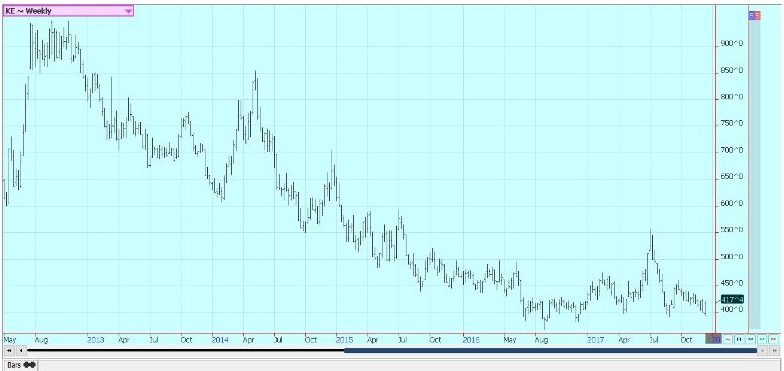
Weekly Chicago Hard Red Winter Wheat Futures © Jack Scoville

Weekly Minneapolis Hard Red Spring Wheat Futures © Jack Scoville
Corn
Corn closed slightly higher last week and oats closed lower. Corn found support when USDA raised its ethanol demand estimates in the monthly supply and demand estimates. Ethanol demand has been stronger than last year, so the increase was justified. Other demand estimates were left unchanged, and ending stocks were lower to account for the better demand. Some speculative buying was seen in corn as funds and other large speculators continue to hold the record or near record short positions in this market. The trade is also looking at the dry weather in southern Brazil and Argentina. Some good and timely rains are in forecasts this week.
Ideas of big supplies and less than great demand keep pulling the market down fundamentally, but it has been the funds who have established a huge and near record short position in futures. Farmers are not selling much corn even in the last part of the harvest due to weak basis and futures price levels. Basis levels have improved, but farmer offers remain down due to the weaker futures prices.
Corn planting is reported to be active in Argentina and southern Brazil. Not much selling is reported in South America. La Nina has started and could create dry weather in South America that could really hurt yields. US prices are cheap now and demand is improving as seen in increased daily announcements of sales of US corn into the world market.
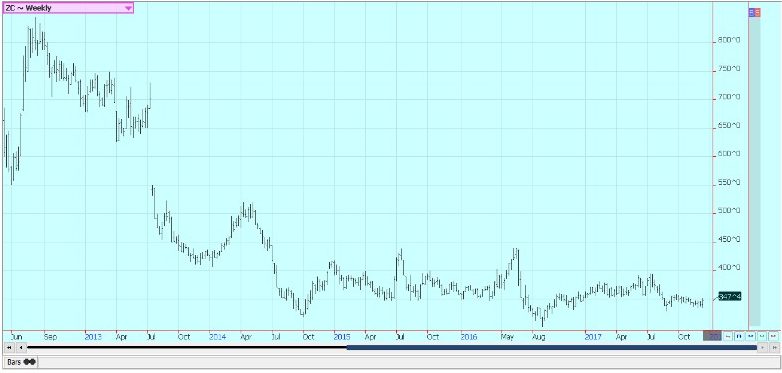
Weekly Corn Futures © Jack Scoville
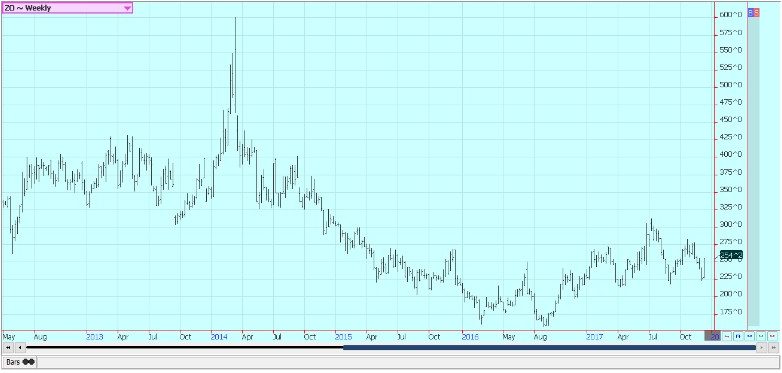
Weekly Oats Futures© Jack Scoville
Soybeans and Soybean Meal
Soybeans and soybean meal were higher for the second half of the week on continued reports of drought in far southern Brazil and parts of Argentina. Soybeans have been stronger due to fears of potential crop losses in southern Brazil and Argentina, but there are forecasts for some timely and significant rains this week. The other fundamental reason for soybeans to work lower was fears of reduced Chinese demand and ideas of improved planting conditions in Brazil and the big production last year in South America that has had Brazil offering for the entire year. Brazil has been able to capture more business that otherwise would have gone to the US due to the huge crop last year.
However, US soybeans are very well priced right now and demand news over the last couple of weeks has improved in a big way as daily sales announcements are once again being seen. China might be forced to reduce demand as the government is making it harder to get safety permits. Some GMO soybeans have made it into the human food chain, and this news has caused the government to slow the process until it can identify the problems. That has not stopped the Chinese crusher from buying US soybeans in the last couple of weeks, and there are hopes that the US can take most of the sales now into early next year. Soybeans have found significant selling on rallies above $10.00 per bushel, but the demand might finally be strong enough for Soybeans to move above that level and test resistance near $10.40 January.

Weekly Chicago Soybeans Futures © Jack Scoville
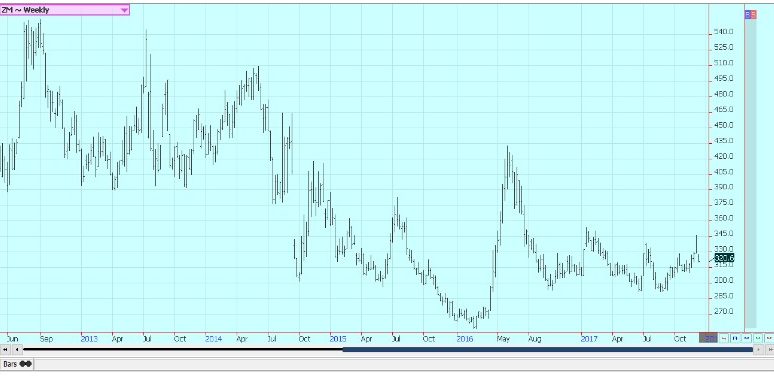
Weekly Chicago Soybean Meal Futures © Jack Scoville
Rice
Rice closed lower for the week in response to the USDA monthly supply and demand updates. USDA left production unchanged. It raised milled Rice exports but cut rough rice exports for an overall cut in export demand. It also raised world production estimates, mostly due to a significant increase in production estimates from China. It was another strong week of export sales, with over 75,000 tons sold into the world market. This good demand has been noted and reflects better US quality and less competition in the western hemisphere.
Mercosur countries have had less to offer, and the US has benefitted from the reduced competition. Futures remain undervalued in relation to the US domestic cash market. However, futures often find a top and work lower in January due to increased farm selling that often surfaces in the first part of the year. The volumes traded are on the light side and reflect the slow domestic cash market. Rice is reported to be mostly sold already in Texas and Louisiana and has been getting sold in other states. Farmers now are more interested in hunting or holiday activities and so buying paddy rice inside the US has been difficult.

Weekly Chicago Rice Futures © Jack Scoville
Palm Oil and Vegetable Oils
World vegetable oils prices were lower again last week, and trends in all three futures markets remain down. The export demand for palm oil has been suffering due to reduced demand from India and a stronger Malaysian currency against the US Dollar. India is the largest importer of vegetable oils in the world and buys a lot of palm oil and soybean oil. Private sources reported weaker exports from Malaysia for November, and demand so far in December has not improved. However, China released strong economic data last week, and there are hopes that demand from that country can improve.
Canola has held better than palm or soybean oil, but trends are down due to some farm selling and weakness in Chicago and Malaysia. It has turned cold in the Prairies and the harvest is about over, so farmers are not as willing to sell. However, deliveries to elevators have been strong due in part to forward selling earlier in the year. Farmers in the US are not selling a lot of soybeans, either, and prices are trying to turn higher.
US demand for soybean oil in biofuels should remain strong as the US moved to put punitive tariffs on imports from Indonesia and Argentina. Both countries are fighting these moves, and the process is moving to the courts in proceedings that should begin in the next couple of weeks. A final decision from the courts and then a real solution to the issue will likely take some time to be found.

Weekly Malaysian Palm Oil Futures © Jack Scoville
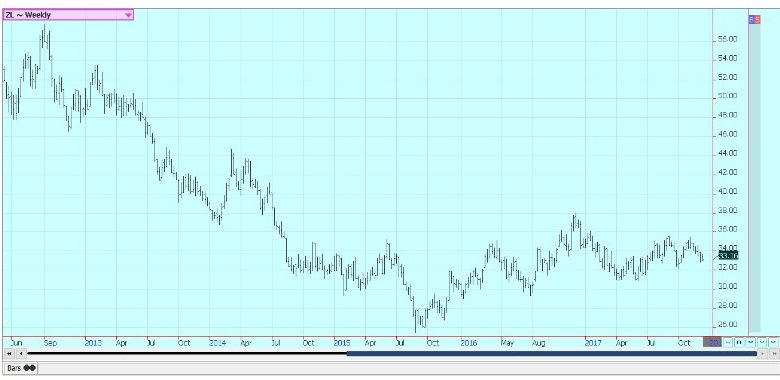
Weekly Chicago Soybean Oil Futures © Jack Scoville
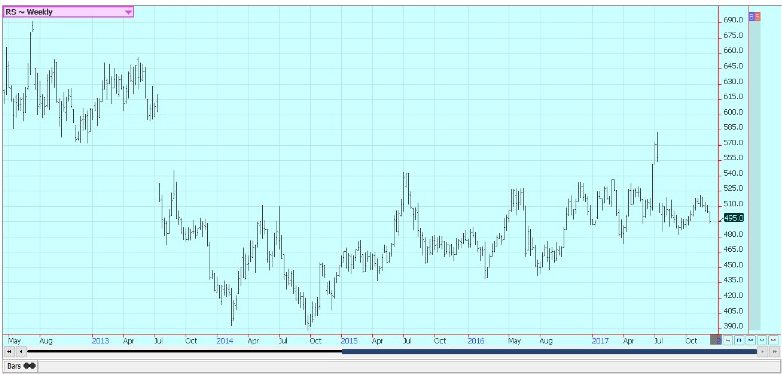
Weekly Canola Futures © Jack Scoville
Cotton
Cotton was higher again last week in response to another week of strong export sales and on ideas that overall demand has been underestimated. USDA aided in these ideas as it increased export demand and cut ending stocks in its monthly supply and demand updates last week. Chart patterns are bullish and a new leg higher could get started at any time. The cotton quality has been dropping as the harvest moves forward, and the lower quality seems to be the biggest effects from the hurricanes seen during the growing season and then the freeze in the west at the tail end of the growing season.
Some traders say that USDA is seriously underestimating demand for the fiber, while the others look to the high USDA ending stocks estimates and suggest that any demand can be easily met. The demand bulls are winning the battle of ideas and price right now. Farmers are reported to be quiet sellers right now. Harvest conditions are good in just about all areas.
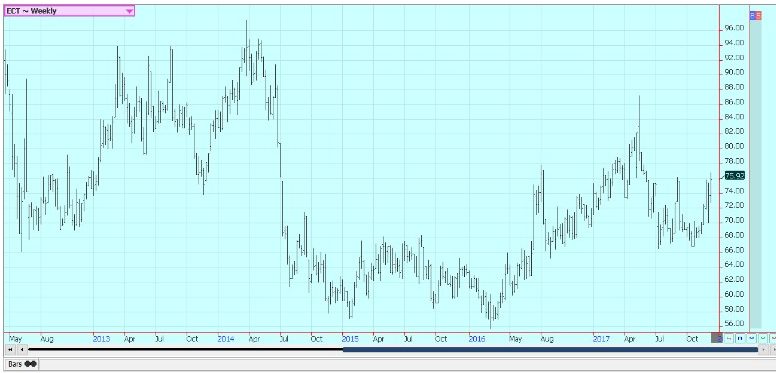
Weekly US Cotton Futures © Jack Scoville
Frozen Concentrated Orange Juice and Citrus
FCOJ felt selling pressure for most of last week, and important chart support at the 150.00 January level was broken. The move came as USDA reduced Florida oranges production to 46 million boxes, the lowest total since 1945 according to wire services reports. However, demand remains the big problem as the consumer continues to look for alternatives, and the potential for better production and more imports from Brazil remains a major issue for the market as well. Short term trends turned down with the price action last week.
Overall weather conditions are considered good in Florida at this time, with mostly dry and warm conditions. The harvest is progressing well and fruit is being delivered to processors and the fresh fruit packers. Trees in Florida that are still alive now are showing fruits of good sizes, although many have lost a lot of the fruit. Florida producers are actively harvesting and performing maintenance on land and trees. The emphasis is on the fresh fruit market now, with processors mostly getting packinghouse eliminations at this time. However, processors are taking deliveries from producers as well.
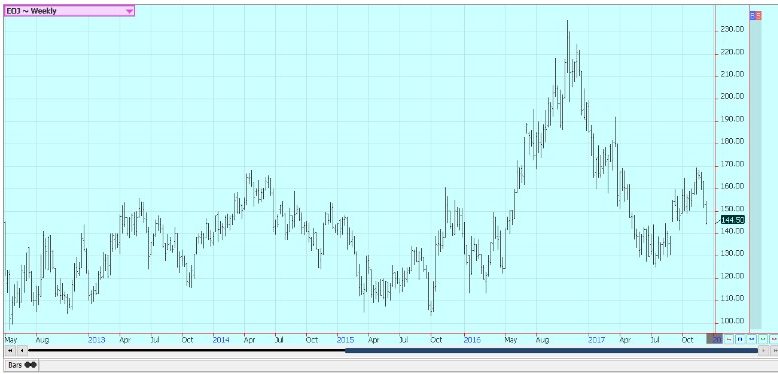
Weekly FCOJ Futures © Jack Scoville
Coffee
Futures were lower in New York and in London for the first part of last week. The funds and other speculators continued to sell with the new downtrend seen on the charts in both markets. The selling started to abate last Wednesday, but Little new buying interest was noted. We were in Vietnam for the last week and saw some farms near the city of Da Lat. Trees were full of fruit and the fruit was turning color. Some harvesting was being seen, and mills were open and producing Green coffee. It looked like a good crop was coming in this area from our farm visits.
The country is looking to replant trees as has been done in parts of Latin America and knows it must improve quality to get better prices. This effort looks to be the focus of the government and industry for the next few years. Internal prices in Vietnam remain at high levels compared to London. The situation seems little changed in Latin America. Brazil exports are reduced at about 2.8 million bags on what is called reduced inventories held by exporters and producers.
Many are concerned about the potential for reduced Brazil production due to earlier drought and the cold and dry winter, although some exporters suggest that the loss potential has been greatly overestimated. There is plenty of rain in some areas now. There are also reports of short crops in parts of Central America and some areas in South America due to the lack of farmer investment from the low prices.
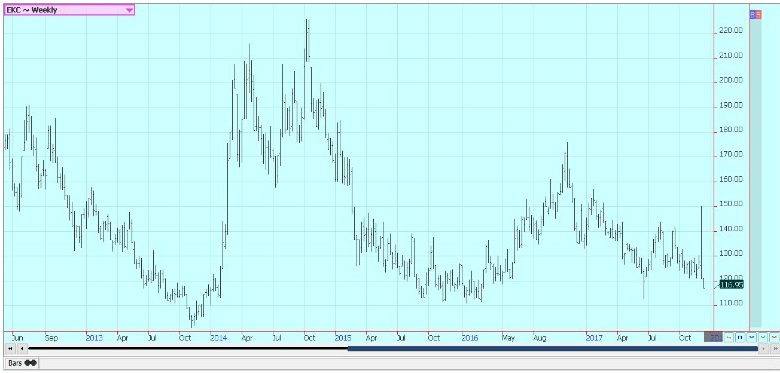
Weekly New York Arabica Coffee Futures © Jack Scoville
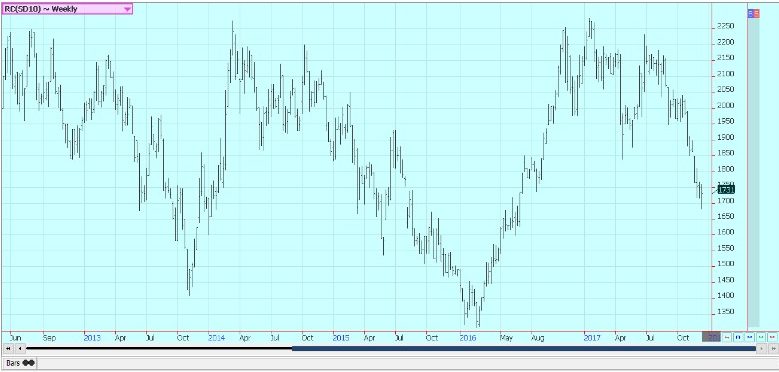
Weekly London Robusta Coffee Futures © Jack Scoville
Sugar
Futures were lower as ideas of big supplies continue to be heard, but began to find some stability in prices in the second half of last week. It was mostly long liquidation in the market as some important resistance areas near 1550 March held and all buyers moved to liquidate. Futures briefly took out the September lows in New York before starting to hold. Next target for the bears will be the June lows near 1350 March.
Price action has been disappointing due to the strong demand for ethanol that has diverted some Brazil mill production away from sugar. Mills in Brazil have decided to make more ethanol as world crude oil and products prices have been very strong.
Ideas are that these prices can continue strong as OPEC and Russia have agreed to keep production constrained compared to world demand. The move comes even as the ISO now estimates the world Sugar production surplus at 5 million tons for the year. There does not seem to be any big Sugar demand and in the end, the lack of demand has kept futures from being able to rally.
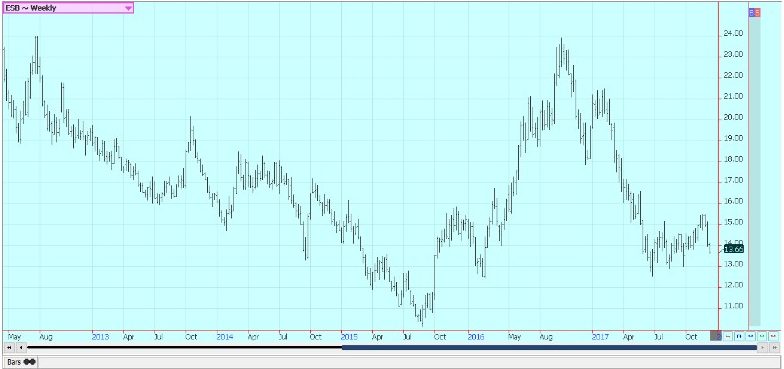
Weekly New York World Raw Sugar Futures © Jack Scoville

Weekly London White Sugar Futures © Jack Scoville
Cocoa
Futures closed lower in volatile trading for the week in both markets, and trends are starting to turn more sideways for now as the West African harvest hits the market. Prices are weak overall due to the ongoing harvest. World production ideas remain high. Harvest reports show good to very good production will be seen this year in West Africa.
Ghana and Ivory Coast expects a very good crop this year. Nigeria and Cameroon are reporting good yields and also good quality. The growing conditions in other parts of the world are generally good. East Africa is getting better rains now. Good conditions are still seen in Southeast Asia and harvest should be strong now amid mostly dry weather.
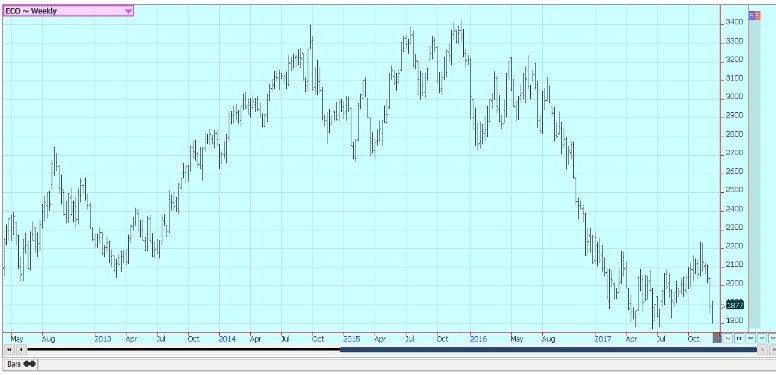
Weekly New York Cocoa Futures © Jack Scoville
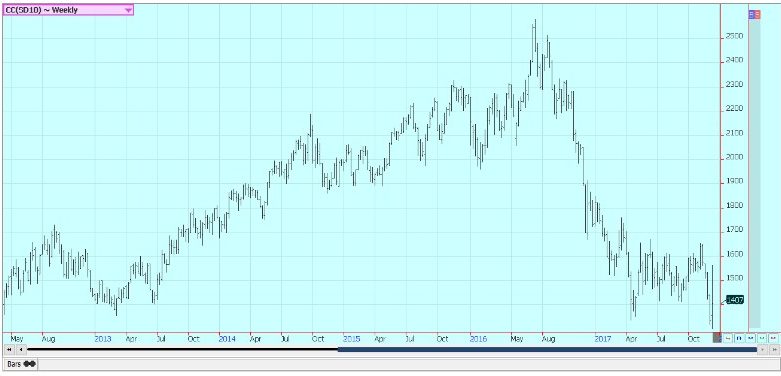
Weekly London Cocoa Futures © Jack Scoville
—
DISCLAIMER: This article expresses my own ideas and opinions. Any information I have shared are from sources that I believe to be reliable and accurate. I did not receive any financial compensation in writing this post, nor do I own any shares in any company I’ve mentioned. I encourage any reader to do their own diligent research first before making any investment decisions.

-

 Africa2 weeks ago
Africa2 weeks agoBank of Africa Launches MAD 1 Billion Perpetual Bond to Boost Capital and Drive Growth
-

 Markets2 days ago
Markets2 days agoCoffee Prices Decline Amid Rising Supply and Mixed Harvest Outlooks
-

 Crypto1 week ago
Crypto1 week agoBitcoin Recovers After U.S. Strikes Iran, While Altcoins Face Sharp Losses
-

 Africa7 days ago
Africa7 days agoMorocco’s Wheat Dependency Persists Despite Improved Harvest


























You must be logged in to post a comment Login